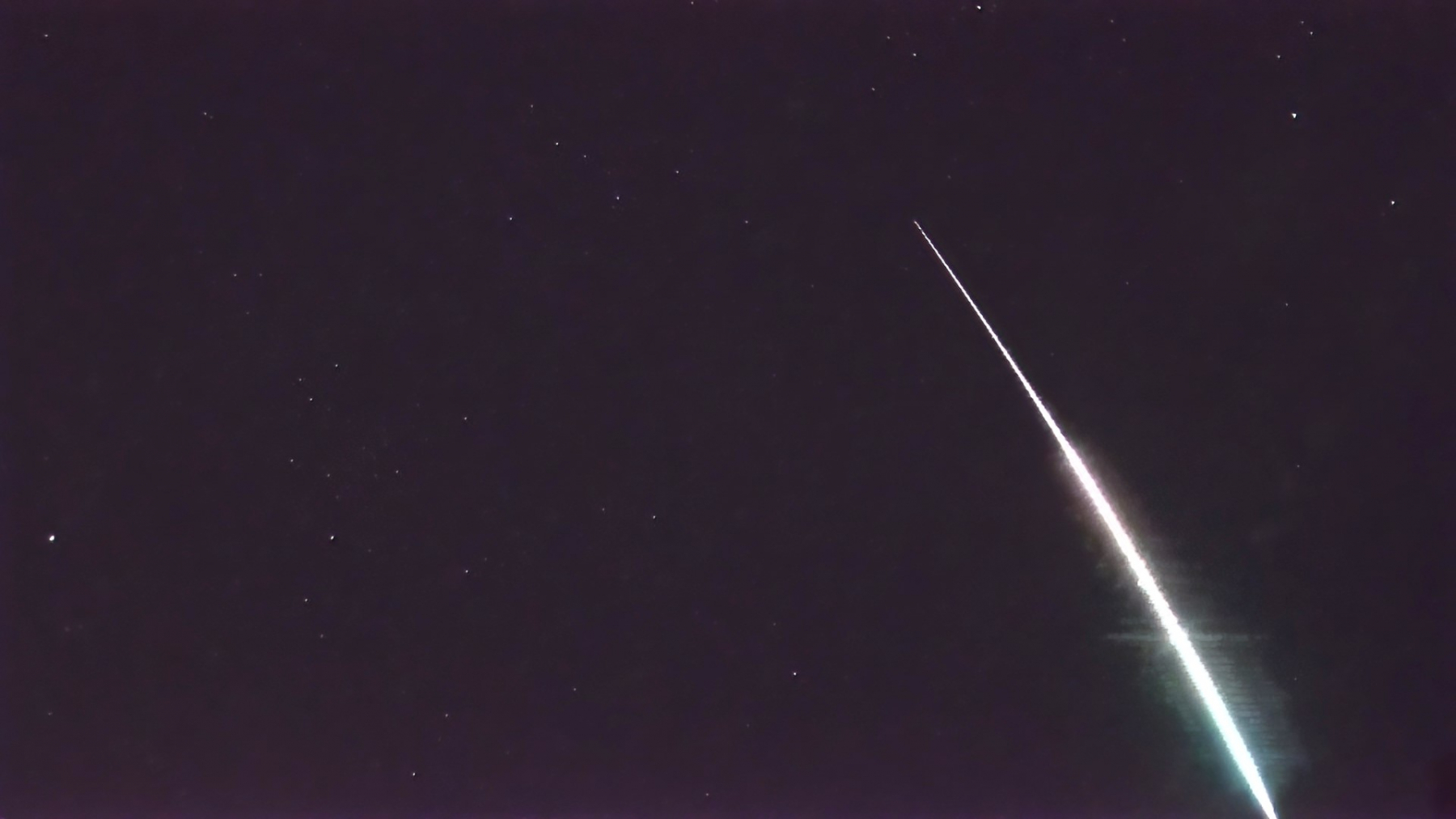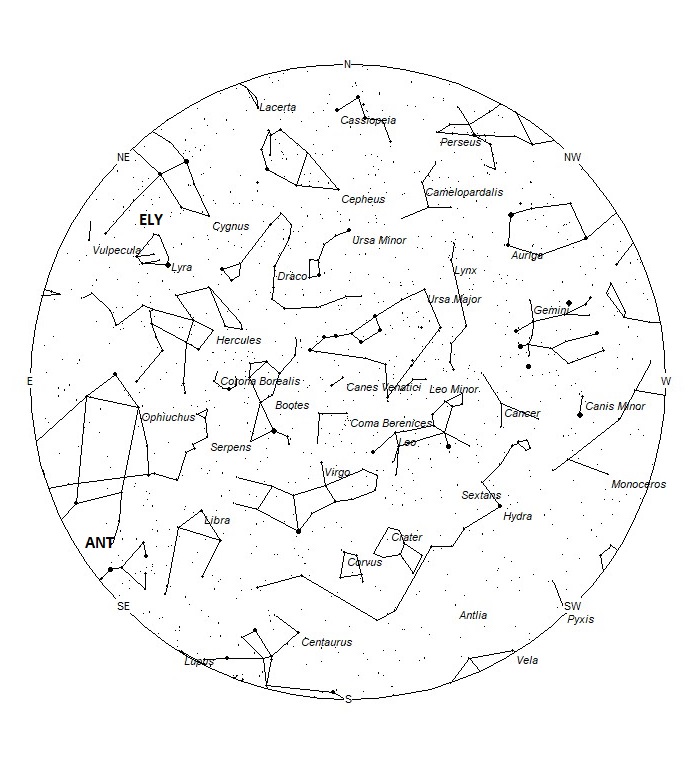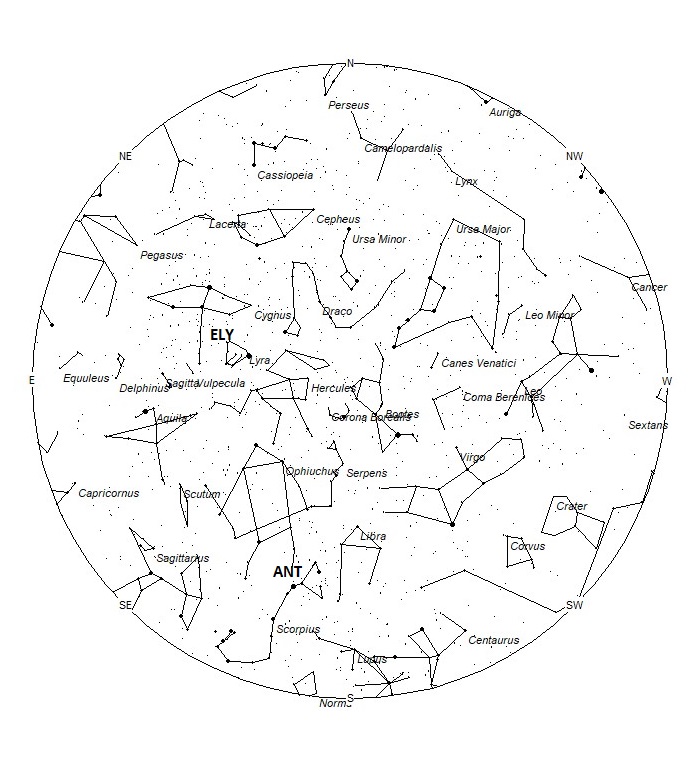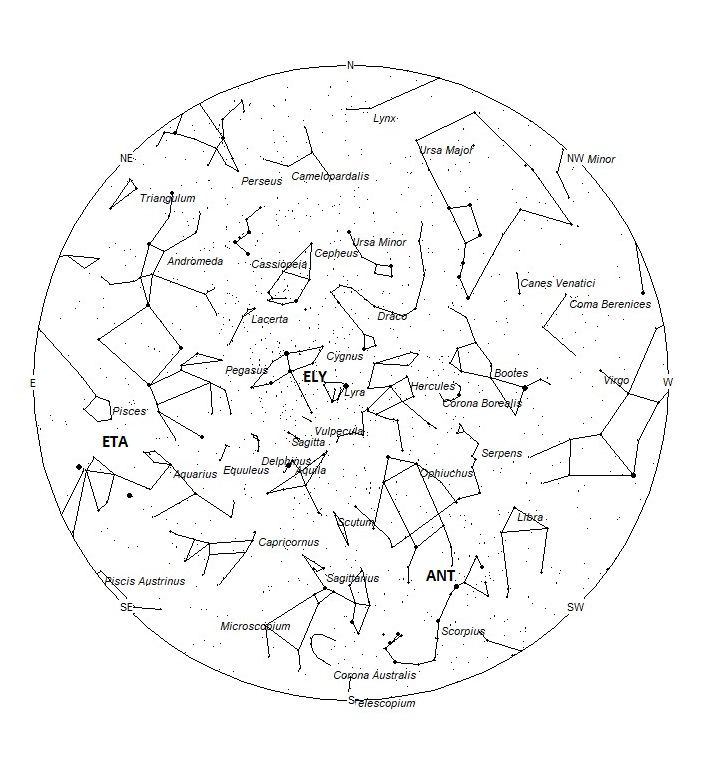 Jordan Ragsdale captured this Orionid fireball using his AllSky Camera System on October 23, 2022, at 01:42 MDT (4:03 UT on August 13) from Eagle, Idaho, USA. For more information on this event visit: https://ams.imo.net/members/imo_view/event/2022/7259 ©Jordan Ragsdale
Jordan Ragsdale captured this Orionid fireball using his AllSky Camera System on October 23, 2022, at 01:42 MDT (4:03 UT on August 13) from Eagle, Idaho, USA. For more information on this event visit: https://ams.imo.net/members/imo_view/event/2022/7259 ©Jordan RagsdaleDuring this period, the moon reaches its new phase on Friday May 19th. At that time the moon will lie close to the sun and will be invisible at night. This weekend the waning crescent moon will rise between 3:00-4:00 local daylight saving time (LDST) and will interfere with observing if you face toward it while viewing meteor activity. It will become less of a nuisance with each passing night as it wanes toward its new phase. The estimated total hourly rates for evening observers this week should be near 3 as seen from mid-northern latitudes (45N) and 4 as seen from tropical southern locations (25S) For morning observers, the estimated total hourly rates should be near 8 as seen from mid-northern latitudes (45N) and 15 as seen from tropical southern locations (25S). The actual rates seen will also depend on factors such as personal light and motion perception, local weather conditions, alertness, and experience in watching meteor activity. Morning rates are reduced slightly due to moonlight during this period. Note that the hourly rates listed below are estimates as viewed from dark sky sites away from urban light sources. Observers viewing from urban areas will see less activity as only the brighter meteors will be visible from such locations.
The radiant (the area of the sky where meteors appear to shoot from) positions and rates listed below are exact for Saturday night/Sunday morning May 13/14. These positions do not change greatly day to day so the listed coordinates may be used during this entire period. Most star atlases (available at science stores and planetariums) will provide maps with grid lines of the celestial coordinates so that you may find out exactly where these positions are located in the sky. I have also included charts of the sky that display the radiant positions for evening, midnight, and morning. The center of each chart is the sky directly overhead at the appropriate hour. These charts are oriented for facing south but can be used for any direction by rotating the charts to the desired direction. A planisphere or computer planetarium program is also useful in showing the sky at any time of night on any date of the year. Activity from each radiant is best seen when it is positioned highest in the sky, either due north or south along the meridian, depending on your latitude. It must be remembered that meteor activity is rarely seen at its radiant position. Rather they shoot outwards from the radiant, so it is best to center your field of view so that the radiant lies at the edge and not the center. Viewing there will allow you to easily trace the path of each meteor back to the radiant (if it is a shower member) or in another direction if it is sporadic. Meteor activity is not seen from radiants that are located far below the horizon. The positions below are listed in a west to east manner in order of right ascension (celestial longitude). The positions listed first are located further west therefore are accessible earlier in the night while those listed further down the list rise later in the night.
These sources of meteoric activity are expected to be active this week.
.
The center of the large Anthelion (ANT) radiant is currently located at 16:24 (246) -22. This position lies in southwestern Ophiuchus, 4 degrees north of the 1st magnitude orange star known as Antares (alpha Scorpii). Due to the large size of this radiant, Anthelion activity may also appear from northwestern Scorpius as well as southern Ophiuchus. This radiant is best placed near 0100 LST, when it lies on the meridian and is located highest in the southern sky. Rates at this time should be near 1 per hour as seen from the Northern Hemisphere and 2 per hour as seen from south of the equator. With an entry velocity of 30 km/sec., the average Anthelion meteor would be of slow velocity.
The last of the eta Lyrids (ELY) are expected this week from a radiant located at 19:24 (291) +42. This area of the sky is located in northeastern Lyra, 4 degrees northeast of the 4th magnitude star known as eta Lyrae. The radiant is also located 9 degrees northeast of the brilliant zero magnitude star known as Vega (alpha Lyrae). This radiant is best placed during the last hour before dawn when it lies nearly overhead in a dark sky. Current rates are expected to be less than 1 per hour no matter your location. These meteors are not well seen from locations south of the equator as the radiant does not rise very high into the northern sky. With an entry velocity of 42 km/sec., the average meteor from this source would be of medium velocity.
The eta Aquariids (ETA) are still active from a radiant located at 22:52 (343) +02. This area of the sky is located in western Pisces, 1 degree southwest of the faint star known as beta Piscium. These meteors are not visible prior to 0200 LST and are best seen just before the start of dawn when the radiant lies highest in the eastern sky. Current hourly rates are expected to range from 5 as seen from the southern tropics to near zero as seen from high northern latitudes. With an entry velocity of 66 km/sec., the average meteor from this source would be of swift velocity.
As seen from the mid-northern hemisphere (45N) one would expect to see approximately 4 sporadic meteors per hour during the last hour before dawn as seen from rural observing sites. Evening rates would be near 2 per hour. As seen from the tropical southern latitudes (25S), morning rates would be near 8 per hour as seen from rural observing sites and 3 per hour during the evening hours. Locations between these two extremes would see activity between the listed figures. Morning rates are slightly reduced due to moonlight.
You can keep track of the activity of these meteor showers as well as those beyond the limits of visual observing by visiting the NASA Meteor Shower Portal. You can move the sky globe to see different areas of the sky. Colored dots indicate shower meteors while white dots indicate sporadic (random) activity. The large orange disk indicates the position of the sun so little activity will be seen in that area of the sky.
The list below offers the information in tabular form of the showers that I feel are within reach of the visual observer to discern. Hourly rates are often less than 1 but noting parameters such as the radiant distance and the elevation of each meteor, one can compute the probability of shower association. Most showers discovered by video means have rates less than 1 meteor per night away from maximum, so the showers listed in these articles are not as weak as they seem. Rates and positions are exact for Saturday night/Sunday morning except where noted in the shower descriptions.
| SHOWER | DATE OF MAXIMUM ACTIVITY |
CELESTIAL POSITION | ENTRY VELOCITY | CULMINATION | HOURLY RATE | CLASS |
| RA (RA in Deg.) DEC | Km/Sec | Local Daylight Saving Time | North-South | |||
| Anthelions (ANT) | – | 16:24 (246) -22 | 30 | 02:00 | 1 – 2 | II |
| eta Lyrids (ELY) | May 10 | 19:24 (291) +42 | 42 | 05:00 | <1 – <1 | II |
| eta Aquariids (ETA) | May 06 | 22:52 (343) +02 | 66 | 08:00 | 2 – 5 | I |
Class Explanation: A scale to group meteor showers by their intensity:
- Class I: the strongest annual showers with Zenith Hourly Rates normally ten or better.
- Class II: reliable minor showers with ZHR’s normally two to ten.
- Class III: showers that do not provide annual activity. These showers are rarely active yet have the potential to produce a major display on occasion.
- Class IV: weak minor showers with ZHR’s rarely exceeding two. The study of these showers is best left to experienced observers who use plotting and angular velocity estimates to determine shower association. These weak showers are also good targets for video and photographic work. Observers with less experience are urged to limit their shower associations to showers with a rating of I to III.
 American Meteor Society
American Meteor Society



Wow, just saw what looked like a meteor approximately 217 degrees southwest during the beautiful sunset tonight at about 8:20 pm central standard 5-13-22. Beautiful, looked like it burnt up and peaked with the point burning bright and the trail fizzling out shortly after. Nice coverage out in dripping springs Texas.